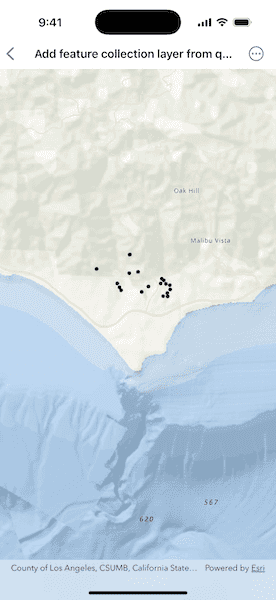Create a feature collection layer to show a query result from a service feature table.

Use case
Consider a national wireless telecommunications company who wants to improve connectivity within areas of poor coverage. Their cell towers, cell tower radii and state boundaries data are held within service feature tables, which can be queried for states that don't meet a certain threshold of coverage. The query result can be used to create and display a single feature collection layer for analysis of areas requiring improved coverage.
How to use the sample
When launched, this sample displays a map with point features as a feature collection layer. Pan and zoom to explore the map.
How it works
- Perform a query using the
queryFeatures(using:)method on aServiceFeatureTable. - Create a
FeatureCollectionTablewith the result of the query. - Create a
FeatureCollectionand add the feature collection table to it. - Create a
FeatureCollectionLayerfrom the feature collection. - Add the feature collection layer to the map's operational layers.
Relevant API
- FeatureCollection
- FeatureCollectionLayer
- FeatureCollectionTable
- FeatureLayer
- FeatureQueryResult
- FeatureTable
- QueryParameters
- ServiceFeatureTable
About the data
This application utilizes data from the wildfire feature service. It loads at full extent with features indicating wildfire response point features across the world.
Tags
layer, query, search, table
Sample Code
// Copyright 2025 Esri
//
// Licensed under the Apache License, Version 2.0 (the "License");
// you may not use this file except in compliance with the License.
// You may obtain a copy of the License at
//
// https://www.apache.org/licenses/LICENSE-2.0
//
// Unless required by applicable law or agreed to in writing, software
// distributed under the License is distributed on an "AS IS" BASIS,
// WITHOUT WARRANTIES OR CONDITIONS OF ANY KIND, either express or implied.
// See the License for the specific language governing permissions and
// limitations under the License.
import ArcGIS
import SwiftUI
struct AddFeatureCollectionLayerFromQueryView: View {
/// A map with an ocean basemap style.
@State private var map = Map(basemapStyle: .arcGISOceans)
/// The error shown in the error alert.
@State private var error: Error?
var body: some View {
MapView(map: map)
.task {
do {
let featureCollection = try await queryFeatures()
let layer = FeatureCollectionLayer(featureCollection: featureCollection)
map.addOperationalLayer(layer)
} catch {
// Updates the error and shows an alert if any failure occurs.
self.error = error
}
}
.errorAlert(presentingError: $error)
}
/// Queries a service feature table and gets a feature collection.
/// - Returns: A feature collection containing the queried features.
private func queryFeatures() async throws -> FeatureCollection {
// A wildfire service feature table to be queried.
let featureTable = ServiceFeatureTable(
url: URL(string: "https://sampleserver6.arcgisonline.com/arcgis/rest/services/Wildfire/FeatureServer/0")!
)
let parameters = QueryParameters()
// Sets the where clause to find all the fire origins and spot fires.
parameters.whereClause = "eventtype=7 OR eventtype=22"
// Queries the service feature table.
let queryResults = try await featureTable.queryFeatures(using: parameters)
let table = FeatureCollectionTable(featureSet: queryResults)
let featureCollection = FeatureCollection(featureCollectionTables: [table])
return featureCollection
}
}